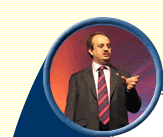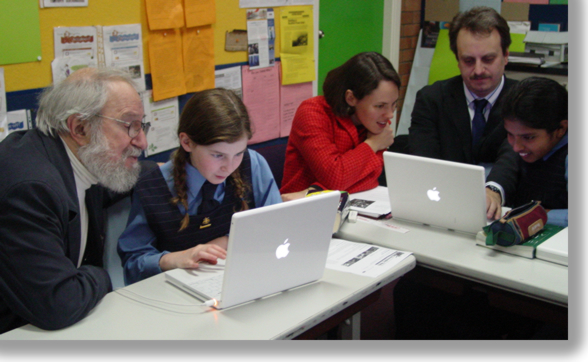Logo and "Logo-like" Programming Environments for Learners
Old-fashioned Quilt Making in an Online Collaborative Setting - Use MicroWorlds EX in this simple open-ended creativity project. (2007)
Making
Aboriginal Dreamtime Designs with MicroWorlds -
An interdisciplinary project (2000)
MicroWorlds
Claymation - Create your own Wallace and Gromit
with one line of code! (2000)
21st
Century Logo Quilts - A Twist on a Classic
Geometry/Art Activity (1999)
Build
Your Own Virtual Pet with MicroWorlds®(1998)
Make Your Own Tamagotchi
©1998-99 Adam Smith with
a bit of help from Gary Stager
Turning Math Manipulatives
Inside Out (1998)
Putting
MicroWorlds Projects on the Web (1998)
For beginners...
MicroWorlds
for Munchkins (1997) (all versions of MicroWorlds)
A brief guide to using MicroWorlds with primary-age students.
Tips
for Creating Multimedia Projects with MicroWorlds 2.0 (Mac/Win
95)
Find out what MicroWorlds 2.0 can do to create multimedia projects and
get busy!
MicroWorlds
Probability (all versions of MicroWorlds)
Simple data collection, collection and graphing.
Editorials from Logo
Exchange by Gary Stager
Books Reviewed by Logo
Exchange
including reviews by Carolyn Dowling.
The
Other Side of Logo Math (all versions of MicroWorlds)
Gain a working understanding of MicroWorlds' mathematical capabilities
in a user-friendly article.
What
can you do with MicroWorlds?
A Personal
Response to the Classic Logo Argument
This article contains Gary's response to educators who wish to return to
the days of less powerful versions of Logo. A review of MicroWorlds 2.0
is included. This article was written for The Logo Update and may appear
there in the future. The article that inspired my response is available here.
MicroWorlds
2.0 Quick Reference Guide by Gary S. Stager
Everything you need to know to get started creating exciting multimedia
projects with MicroWorlds 2.0 for the Macintosh. Feel free to print it
out!
MicroWorlds
1.x Quick Reference Sheets
You will need to print this document since some of the "text" is
a graphic.
MicroWorlds
1.x Turtle Graphics Primitive List
You will need to print this document since some of the "text" is
a graphic.
Build
Your Own Geometry Toolkit Materials
Now your students can use MicroWorlds to collaboratively design their own
powerful Eudlidian geometry tools!
MicroWorlds
Board Game Project
This describes a simple open-ended project your
students can use to explore randomness, probability and logic.
MicroWorlds
Data Graphing Project
This describes a simple open-ended project your students create their own
simple mathematical graphing tools.
25 Things
to Do with LEGO TC logo or Control Lab Use these simple ideas to
inspire magnificent problem solving.
Logo-Using
Educator Resource List
This document contains a list of books every constructivist teacher should
read, where to buy Logo, organizations worth joining and online resources.
Links to important resources are included!
What
is Logo? And Who Needs it? A 1999 essay by Seymour
Papert from LCSI's book, Logo Philosophy and Implementation.
Video
Game Workshop
Play the games designed by students of Hope Chafiian of Spence School and
Michael Tempel of the Logo Foundation.
Seymour Papert's keynote address at the International One-to-One Computing Conference
Sydney, Australia - June 2004
Seymour Papert's interview on Australian radio
June 2004
Homepage
for Brian Harvey (bh@cs.Berkeley.EDU)
Computer scientist and UC Berkeley Lecturer, Brian Harvey,
is a Logo pioneer. This web-site has information on his fantastic Computer
Science Logo Style book series, his recent Scheme book
and several provocative articles on education and Logo. Brian's
next edition of Computer Science Logo Style are now
available from MIT
Press and for free download from his site.
Logo Computer Systems, Inc.
Homepage
LCSI is the company responsible for LogoWriter, MicroWorlds,
My Make Believe Castle and other leading software construction
environments for kids. Seymour
Papert is LCSI's chairman.
The Logo
Foundation is a nonprofit organization dedicated to the educational
use of Logo. The Foundation publishes, "The Logo Update" three
times a year.
Whatever
Happened to the Revolution? is the transcript for a terrific keynote
address delivered by Dr. Geraldine Kozberg at the 1996 Logosium conference
in St. Paul, Minnesota.
| |
Planet
Papert
|
- Articles by Seymour Papert
- Interviews with Seymour Papert
- Reviews of books by Seymour
Papert
|
 The
New Media and Education Reform was the name of a panel discussion
held at the MIT Media Lab on June 4, 1996. The panelists included:
Seymour Papert, Howard Gardner, Sherry Turkle and Mitchel Resnick.
Information on ordering audio and video cassettes are available
at this site. Here is
an American Prospect article, " Access
is not Enough - Computer Clubhouses In the Inner City," by Mitchel
Resnick and Natalie Rusk presented at this conference. Seymour
Papert delivered a fantastic speech that is well worth spending
$5 to receive on audiotape.
The
New Media and Education Reform was the name of a panel discussion
held at the MIT Media Lab on June 4, 1996. The panelists included:
Seymour Papert, Howard Gardner, Sherry Turkle and Mitchel Resnick.
Information on ordering audio and video cassettes are available
at this site. Here is
an American Prospect article, " Access
is not Enough - Computer Clubhouses In the Inner City," by Mitchel
Resnick and Natalie Rusk presented at this conference. Seymour
Papert delivered a fantastic speech that is well worth spending
$5 to receive on audiotape.
Educational
Computing: How are We Doing? is a recent article by Seymour
Papert published in the 25th Anniversary Issue of the the T.H.E.
Journal.
StarLogo by
Mitchel Resnick is a programmable modeling environment for
exploring the behaviors of decentralized systems, such as bird
flocks, traffic jams, and ant colonies. It is designed especially
for use by students. StarLogo is designed to help students
(as well as researchers) develop new ways of thinking about
and understanding decentralized systems. StarLogo is particularly
well-suited for Artificial Life projects. Mitchel Resnick's
book about StarLogo, "Turtles,
Termites, and Traffice Jams: Explorations in Massively Parallel
MicroWorlds," may be purchased here.
Exploring
Emergence is a dynamic paper written by Brian Silverman
and Mitchell Resnick designed to demonstrate issues associated
with cellular automata and artificial life. It is an evocative
model of how text can be brought to life on the WWW. You
need a Java-enabled browser, such as Netscape
Navigator 3.0, to interact with the examples.
Homepage
for Yasmin Kafai (kafai@gse.ucla.edu)
Yasmin conducts research and teaches at UCLA. She is a former
student at the MIT Media Lab's Epistemology and Learning
Group. Her research involves
kids designing educational video games. Her most recent book is entitled, "Minds
in Play: Computer Game Design as a Context for Children's Learning."
Computer Programming for Kids
- Using MicroWorlds Project Builder
A proud father's sharing of MicroWorlds work done by his child. This is
a really cute site.
MicroWorlds
Tips from David Potter at John Paul College - Australia
David Potter, an Australian educator, has created this page full of tips
for MicroWorlds users.
LEGO TC logo
projects from Thomas Starr King Middle School in Los Angeles.
A French Logo Site -
Eurologo
The Logo-l Listserve
Archive - messages posted to the Logo listserve in the
past.
Organizations
The Logo Foundation is a non-profit organization dedicated
to supporting Logo-use around the world. The Logo Foundation
collects and distributes Logo materials to interested educators.
The Foundation also publishes a newsletter, Logo Update ,
four times a year. Subscriptions are free. Contact:
The Logo Foundation
250 West 57th Street
NY, NY 10107-2228 USA
Fax: 212-765-4789
Email: MichaelT@media.mit.edu
Logo Foundation Listserve :
Send message to: majordomo@gsn.org
subscribe logo-L in the body of the message
Send questions to: logofdn@gsn.org
CLIME (Council for Logo in Mathematics Education). CLIME News
is published 3-4 times each year, plus a Microworld issue.
CLIME is an NCTM affiliate organization. Membership costs $15/year.
Contact:
CLIME
10 Bogert Avenue
White Plains, NY 10606
or send mail to Ihor at:icharisc@vaxc.stevens-tech.edu
NCTM (National Council of Teachers of Mathematics). Membership
is $40 and includes either the Arithmetic Teacher or Mathematics
Teacher . Contact:
NCTM
1906 Association Drive
Reston, VA 22091
MIT Epistemology & Learning
Group Online Resources
Visit the MIT Media Lab (Home of Seymour
Papert, the Father of Logo) at HTTP://www.media.mit.edu .
Epistemology and Learning Publications
The MIT Media Laboratory
20 Ames Street Room E15-309
Cambridge, MA 02139
FTP server site.
To get access to the following papers, you must use anonymous FTP. To do
this, type the command ftp cher.media.mit.edu to
the command line prompt of your Unix machine.


